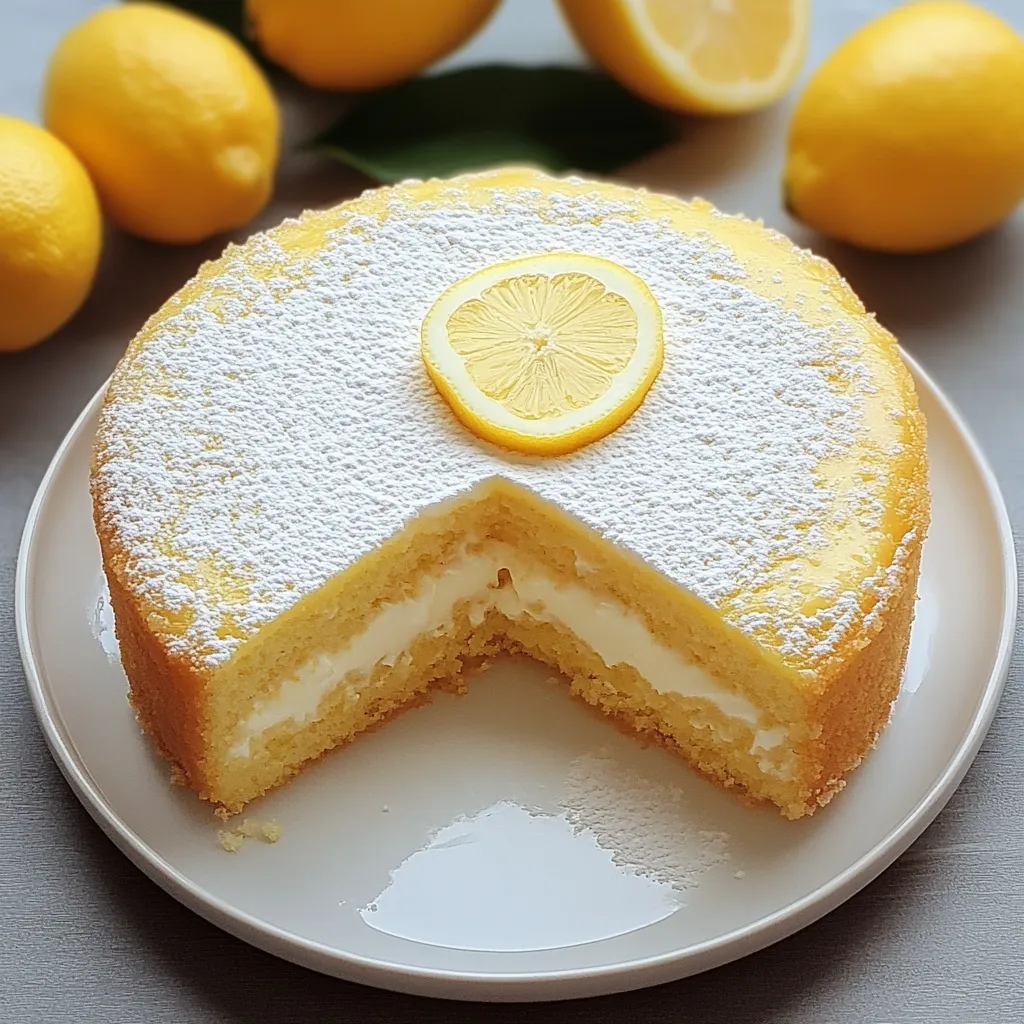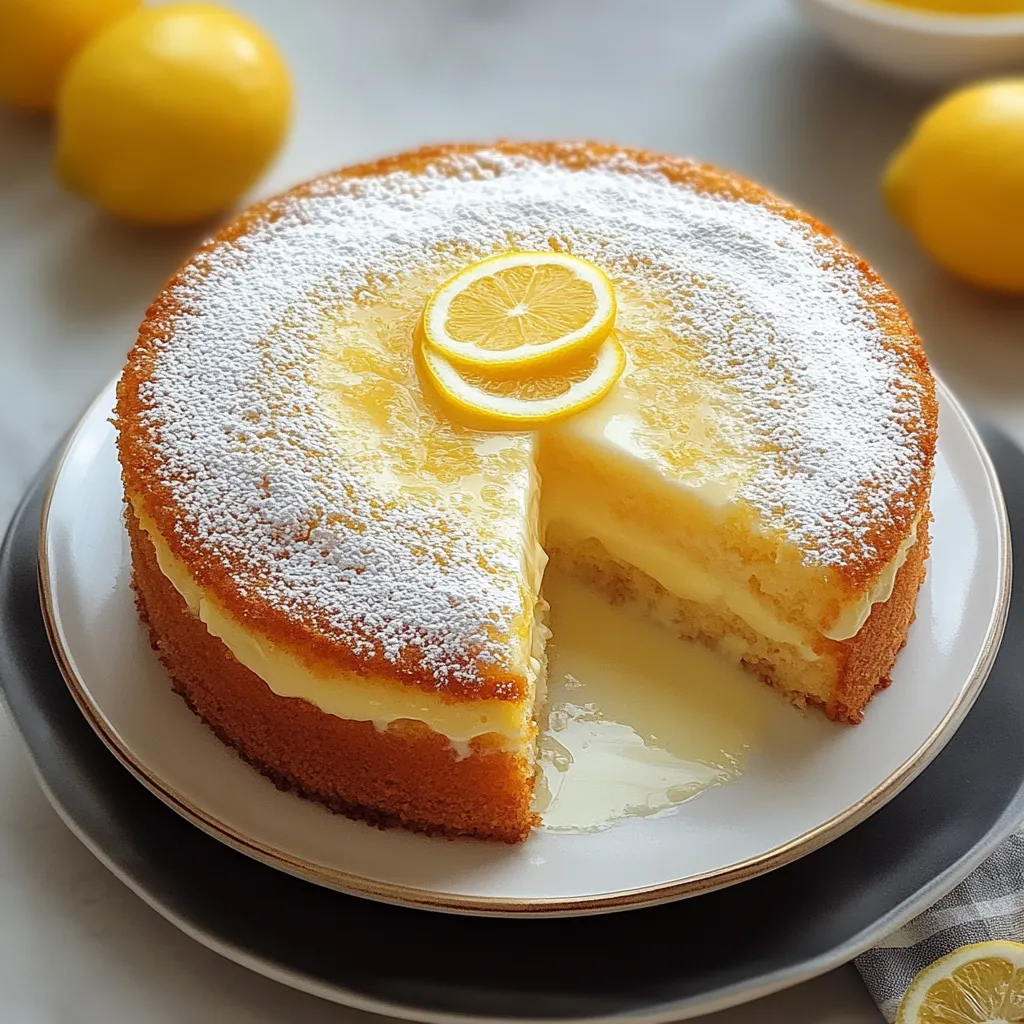 Pin it
Pin it
Lemon custard cake delivers pure magic through culinary science, creating two distinct layers from one simple batter. The first bite reveals an airy, delicate cake top that gives way to a velvety smooth custard layer beneath, all infused with bright lemon essence that balances the richness perfectly. This remarkable dessert captivates both visually and on the palate, with its golden surface and sunshine-yellow interior offering a promise of the citrusy delight to come. Unlike traditional cakes, this creation transforms during baking, naturally separating into distinct textures that provide a contrasting experience with each spoonful. The lemon contributes more than mere flavor, cutting through the creamy richness with its vibrant acidity while adding subtle aromatic notes that elevate the entire dessert.
My relationship with this cake began during a spring visit to my grandmother's farmhouse. She served what looked like a simple lemon cake that somehow transformed into the most incredible custard experience I'd ever tasted. The recipe had been passed through generations, handwritten on a weathered index card simply titled "Magic Lemon Cake." What struck me most was how such basic ingredients could create something so extraordinary. After inheriting her recipe collection, this became my signature dessert for gatherings where I wanted something impressive without spending hours in the kitchen. Friends consistently request it for special occasions, often commenting that it manages to satisfy both light dessert lovers and those craving something more substantial.
Perfect Ingredients
- ¾ cup granulated sugar: Balances the lemon's acidity while contributing to the cake's structure; superfine sugar incorporates more easily if available.
- ¼ cup unsalted butter, melted: Adds richness and tenderness; European-style butter with higher fat content produces exceptional results.
- 3 tablespoons lemon zest: Infuses aromatic citrus oils throughout both layers; approximately 2-3 medium lemons yield this amount.
- ⅓ cup fresh lemon juice: Provides bright acidity central to the flavor profile; always use fresh rather than bottled for superior taste.
- 4 large eggs, separated: Create the magical separation during baking; room temperature eggs incorporate more effectively.
- ¾ cup all-purpose flour: Provides just enough structure without weighing down the delicate texture; measure by spooning into cups then leveling.
- ¼ teaspoon baking powder: Contributes subtle lift to the cake layer; check expiration date for optimal performance.
- ¼ teaspoon salt: Enhances all flavors while balancing sweetness; fine sea salt distributes most evenly.
- 1¾ cups whole milk: Creates the custard foundation; the fat content in whole milk is essential for proper texture development.
Baking Process
- Prepare Your Space:
- Position oven rack to the middle position and preheat to exactly 325°F. Butter a 9-inch round cake pan thoroughly, then line the bottom with parchment paper cut to fit precisely. The parchment ensures clean removal of this delicate dessert. Gather all ingredients, allowing refrigerated items to reach room temperature for optimal incorporation.
- Begin With Flavor Base:
- In a large bowl, whisk together sugar and melted butter until completely smooth and slightly lightened in color. The sugar crystals should begin dissolving into the butter, creating a gritty paste that will fully incorporate later. Add lemon zest, rubbing it into the sugar mixture with your fingertips to release essential oils that carry intense flavor.
- Introduce Structure:
- Separate eggs, placing whites in a completely clean, dry bowl for later use. Add yolks one at a time to your sugar mixture, whisking thoroughly between each addition until the batter appears smooth and glossy. The yolks contribute richness to the custard layer while providing emulsification.
- Add Brightness:
- Pour fresh lemon juice into your batter, whisking constantly. The mixture may appear slightly curdled at this stage, which is completely normal. The acidity temporarily affects the emulsion but will incorporate smoothly as remaining ingredients are added.
 Pin it
Pin it
The first time I attempted this cake, I was skeptical about how a single batter could create two layers. But as it baked, I watched in amazement as the transformation happened. The airy cake rose while the custard layer set, forming the perfect contrast. Since then, it has become my go-to dessert for springtime celebrations, always leaving guests in awe of its delicate balance of textures and flavors.
Serving Inspiration
Transform this simple cake into an elegant dessert through thoughtful presentation. For special occasions, serve individual portions on small plates with fresh berries scattered around the base. The vibrant berry colors contrast beautifully with the pale yellow cake while complementing the lemon flavor. A light dusting of powdered sugar adds visual appeal without overwhelming sweetness.
For a dramatic finishing touch, lightly torch the top of the cake with a kitchen torch after dusting with sugar. This creates a delicate, caramelized crust that adds a slight crunch, beautifully contrasting the creamy custard layer beneath. Pair with a citrus-infused whipped cream for an extra indulgent experience.
Storage Solutions
While best enjoyed the day it's made, this cake maintains quality when properly stored. Allow it to cool completely before covering loosely with plastic wrap and refrigerating. The custard layer actually intensifies overnight as the flavors meld and textures stabilize. When stored correctly, it maintains quality for up to three days, though the cake layer gradually absorbs moisture from the custard, becoming slightly less distinct.
If you plan to serve it the next day, remove from the fridge at least 20 minutes before slicing. This allows the custard to soften slightly, creating the ideal contrast between the fluffy cake top and silky custard base. For longer storage, wrap individual slices in plastic and freeze for up to one month, thawing overnight in the fridge before serving.
 Pin it
Pin it
Final Thoughts
This lemon custard cake continues to fascinate me after years of baking it for family and friends. Something about its magical transformation in the oven from simple batter to elegant dual-textured dessert never loses its charm. The recipe's brilliant simplicity reminds me that extraordinary culinary experiences don't always require complicated techniques or exotic ingredients. Sometimes the most impressive creations come from understanding how familiar components interact under specific conditions, creating something greater than the sum of their parts.
Frequently Asked Questions
- → How does the cake separate into two layers?
- The magic of the Lemon Custard Cake happens during baking through simple science. The thin batter naturally separates as it bakes because the flour rises to the top, forming the cake layer, while the heavier ingredients sink to the bottom, creating the custard. The high liquid-to-flour ratio is crucial for this separation to occur. The eggs also play an important role - they provide structure to the cake layer while contributing to the richness of the custard. For the best defined layers, make sure to pour the batter gently into the pan and avoid jostling it as you place it in the oven.
- → Can I use bottled lemon juice instead of fresh?
- While you can technically use bottled lemon juice in the Lemon Custard Cake, fresh lemon juice will give you significantly better results. Bottled juice often has a somewhat flat, slightly bitter taste compared to the bright, vibrant flavor of freshly squeezed lemons. Additionally, this recipe calls for lemon zest, which can only come from fresh lemons and contains essential oils that provide much of the aromatic lemon flavor. If you must use bottled juice, add an extra 1/2 teaspoon of zest if possible, and choose a high-quality bottled juice without additives.
- → Why did my cake not separate into distinct layers?
- Several factors could prevent your Lemon Custard Cake from forming distinct layers. First, overmixing the batter can incorporate too much air, disrupting the natural separation. Mix just until ingredients are combined. Second, oven temperature is crucial - if your oven runs hot, the top may set too quickly before separation occurs, so consider using an oven thermometer. Third, the milk temperature matters - make sure it's at room temperature, not cold from the refrigerator. Finally, the baking time needs to be right - if underbaked, the layers won't fully develop; if overbaked, they can become less distinct as the custard solidifies too much.
- → Can I make this cake ahead of time?
- Lemon Custard Cake is perfect for making ahead! In fact, many people find the flavor improves after the cake has been refrigerated overnight, as the lemon notes develop and meld. You can make it up to 2 days before serving. After baking, allow it to cool completely, then cover it tightly with plastic wrap and refrigerate. If you'd like to serve it at room temperature, take it out of the refrigerator about 30 minutes before serving. For an extra special presentation, dust it with fresh powdered sugar just before bringing it to the table.
- → Can I make this cake without dairy?
- Creating a dairy-free version of Lemon Custard Cake is challenging but possible with some careful substitutions. For the butter, use a plant-based butter substitute that has similar fat content (not margarine). For the milk, full-fat coconut milk is your best option as it has the richness needed for the custard layer to form properly. Almond or oat milk may be too thin unless you find barista versions with higher fat content. Be aware that these substitutions will change the flavor profile somewhat, and the separation between layers might not be as distinct. The coconut flavor will also be noticeable, though it pairs well with lemon.
